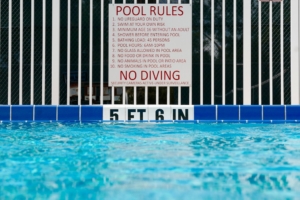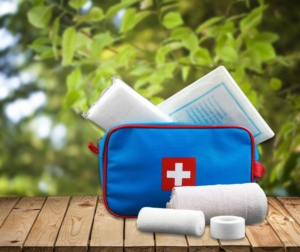May is National Water Safety Month, and at the Y, we believe in the importance of teaching people of all ages how to be safe in and around water. Here, our Aquatics Team put together some quick water safety tips.
 Achieve basic swim skills: take swim lessons to learn how to get comfortable in the water, float, tread, kick and how to safely enter/exit the water.
Achieve basic swim skills: take swim lessons to learn how to get comfortable in the water, float, tread, kick and how to safely enter/exit the water.
Buddies swim together: swimming with a friend helps keep you safe because a friend can call for help if needed and someone always knows where you are.
Clean, clear water: pool water should be clear, not cloudy, and clean. You should be able to see the bottom. Natural bodies of water should be clear of debris and clean. Check for signs indicating whether the water has been tested for bacteria.
Drink plenty of fluids: when you swim you sweat but you don’t feel it, so be sure to stay hydrated by drinking water.
Enter water feet first: sometimes it’s not easy to see how deep the water is – be safe by going in feet first; never dive into water when you don’t know its depth.
Follow the rules: safe pools have rules and are in place to keep everyone safe.
Get permission to swim: always ask a parent or caregiver if it’s ok to swim.
Holding your breath is a no-no!: breath holding games in the water can cause underwater fainting due to the lack of oxygen to your brain brought on by holding your breath for long periods of time.
 Identify designated swim areas: safe pools have safety lines indicating where the depth changes from shallow to deep and markings along the perimeter indicating the depth of the water; natural bodies of water should also indicate safe swim areas.
Identify designated swim areas: safe pools have safety lines indicating where the depth changes from shallow to deep and markings along the perimeter indicating the depth of the water; natural bodies of water should also indicate safe swim areas.
Jump away from edge: when jumping into a pool, be sure to jump away from the edge to avoid hitting your head on the side of the pool.
Know how to call 9-1-1: when calling for assistance be sure to remain calm, speak clearly, know your location with the address and phone number, know your surroundings so that you can describe where you are, and don’t hang up.
Lifeguards on duty: safe swim areas have lifeguards watching swimmers.
Maintain constant adult supervision: parents and caregivers should never leave a child alone near any body of water, including bath tubs.
Never swim alone: no matter how well you swim, swimming alone is dangerous. Inexperienced and weak swimmers should have supervision at all times. Experienced swimmers can encounter dangers in the water as well such as cramps, fatigue, or they can swim too far away from shore or the edge of the pool and not have the strength to return.
 Organize a first aid kit: keep the following items in a basic first aid kit when swimming – band-aids, antiseptic wipes, insect sting relief gel or spray, gauze pads, antibacterial soap, hand sanitizer, instant ice packs, sun screen, bottled water and a whistle for warnings and to call for help.
Organize a first aid kit: keep the following items in a basic first aid kit when swimming – band-aids, antiseptic wipes, insect sting relief gel or spray, gauze pads, antibacterial soap, hand sanitizer, instant ice packs, sun screen, bottled water and a whistle for warnings and to call for help.
Protect your skin from the sun: always wear sunscreen when at an outdoor pool, beach, or lake; wear a hat, and use umbrellas to give yourself a break from the sun.
Quickly exit in a lightning storm: swimming in a lightning storm is one of the most dangerous things you can do. Lightning regularly strikes water and since water conducts electricity, a nearby storm could injure you. When you hear thunder or see lightning, you should get out of the water and into a safe place.
Reach, throw, DON’T GO: If you want to help someone who is in the water and is in trouble, first call/yell for help. Then lie down on the ground on your belly, extend your arm to reach for the person. If you can’t reach the person, throw something that floats like a swim noodle. Don’t ever go into the water to assist someone who is struggling.
Safety slide in: enter the water safely by sliding into the water. This allows you to adjust to the temperature of the water and get an idea of the depth.
Tread water: learning to tread water is an important safety skill. When you get tired or need a break, it’s important to know how to swim in place with your head out of the water in order to conserve energy.
 US Coast Guard approved lifejackets: all non-swimmers, inexperienced swimmers, boaters and those participating in water sports such as water skiing should wear a properly fitted US Coast Guard approved lifejacket. The lifejacket should fit snuggly so that it doesn’t ride up into the face and should be free of rips, tears and holes.
US Coast Guard approved lifejackets: all non-swimmers, inexperienced swimmers, boaters and those participating in water sports such as water skiing should wear a properly fitted US Coast Guard approved lifejacket. The lifejacket should fit snuggly so that it doesn’t ride up into the face and should be free of rips, tears and holes.
Voice safety concerns: if you see something that doesn’t appear safe, say something to the lifeguard or pool/beach manager.
Water temp: swimming in water that is too cold can cause hypothermia. Symptoms of hypothermia include: shivering; slurred speech; shallow breathing; lack of coordination; confusion; drowsiness; loss of consciousness, and bright, red skin.
If someone is experiencing these symptoms, remove them from the cold, remove wet clothing and cover the person with blankets. If symptoms persist, transport them to an emergency room immediately.
Xtra caution in rivers, lakes, ocean: when swimming in natural bodies of water, extra caution needs to be observed. Be aware of currents, rip tides, possible bacterial contamination, algae, rocks and depth.
Young/non-swimmers wear lifejackets: all young children who are inexperienced swimmers or non-swimmers should wear a lifejacket.
Zip your lifejacket: lifejackets should fit snuggly so that they don’t ride up into the face. They should be properly secured with all straps and zipped.

